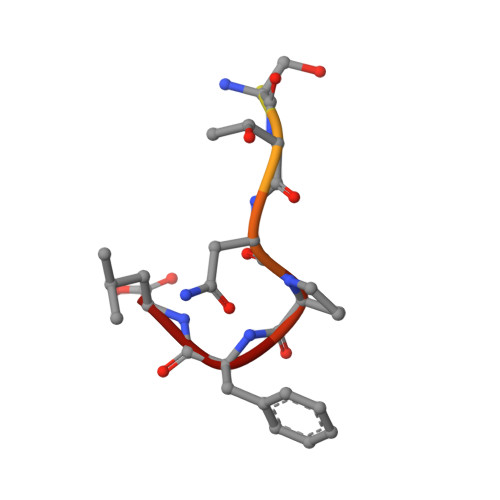Molecular mechanism of NPF recognition by EH domains.
de Beer, T., Hoofnagle, A.N., Enmon, J.L., Bowers, R.C., Yamabhai, M., Kay, B.K., Overduin, M.(2000) Nat Struct Biol 7: 1018-1022
- PubMed: 11062555
- DOI: https://doi.org/10.1038/80924
- Primary Citation of Related Structures:
1F8H, 1FF1 - PubMed Abstract:
Eps15 homology (EH) domains are protein interaction modules that recognize Asn-Pro-Phe (NPF) motifs in their biological ligands to mediate critical events during endocytosis and signal transduction. To elucidate the structural basis of the EH-NPF interaction, the solution structures of two EH-NPF complexes were solved using NMR spectroscopy. The first complex contains a peptide representing the Hrb C-terminal NPFL motif; the second contains a peptide in which an Arg residue substitutes the C-terminal Leu. The NPF residues are almost completely embedded in a hydrophobic pocket on the EH domain surface and the backbone of NPFX adopts a conformation reminiscent of the Asx-Pro type I beta-turn motif. The residue directly following NPF is crucial for recognition and is required to complete the beta-turn. Five amino acids on the EH surface mediate specific recognition of this residue through hydrophobic and electrostatic contacts. The complexes explain the selectivity of the second EH domain of Eps15 for NPF over DPF motifs and reveal a critical aromatic interaction that provides a conserved anchor for the recognition of FW, WW, SWG and HTF ligands by other EH domains.
- Department of Pharmacology, University of Colorado Health Sciences Center, 4200 East Ninth Avenue, Denver, Colorado 80262, USA. Tony.Debeer@uhsc.edu
Organizational Affiliation:


















